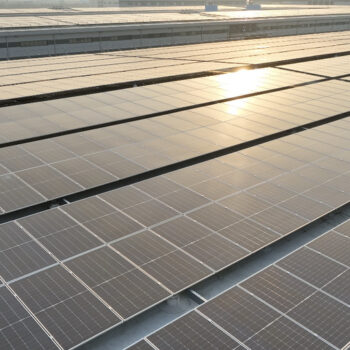David Wallerstein is Tencent’s Chief eXploration Officer. Over the past several years, he has been focused on improving sustainability by working extensively with scientists, institutions, industry and organizations to accelerate the essential energy transition and work towards carbon neutrality.
Wallerstein was recently invited by the International Dialogue on Energy Transitions to share some high-level concepts for how the internet industry, including the cloud, software, data, artificial intelligence, and machine learning, can play an important role in the energy transition.
The forum was held by the National Energy Administration of China and the International Renewable Energy Agency. Among the attendees were Dr. Fatih Birol, Executive Director of the International Energy Agency, Francesco La Camera, the Director-General of the International Renewable Energy Agency (IRENA), and other leaders and bright minds pushing us towards a more sustainable world.
The article below is an edited version of a speech that Wallerstein gave at the event.

As our energy generation and storage sources multiply and decentralize, and consumers of electricity increase, we face more complex and challenging requirements. But we also see significant opportunities to drive efficiencies that result in prioritization of green energy sources.
The market can be redesigned to reward the most efficient strategies, reducing overall waste by curbing power demand, leveling out spikes and driving productivity.
I believe we face a major opportunity to embrace software, clouds and artificial intelligence (AI) to reimagine the operation of our energy ecosystems. We could even call this an “Internet of Energy” that awaits on the horizon.
The potential for innovation in the “software layer” of energy markets has been discussed for years. The software layer involves both market rules, such as pricing and taxation, and the software running through the entire energy system to analyze, forecast, and intelligently actuate by performing tasks like controlling a pump or an air conditioning system.
Software, AI and other IoE innovations make all this – and much more – possible.
SOFTWARE BRINGS EVERYTHING TOGETHER
For a moment, let’s move away from the messy real world, where getting things done can be painful and complex.
Imagine the price of energy is entirely dynamic, real-time and open for incremental participants to sell their energy to the grid. Pricing of this energy could accurately reflect both the extent to which it is green (its Co2 quotient), efficiently produced or abundant. On a day when local wind production was at 100 percent capacity, you would assume the price of wind-generated energy is by far the lowest in your system and a fossil fuel-based method is the most expensive.
If we can establish this kind of pricing hierarchy, transparent to the general market, we can create an ecosystem for third-party AI-driven energy optimization applications to be developed of many kinds of situations and industries.
SOFTWARE SOLUTIONS OPTIMIZE THE ENERGY ECOSYSTEM
Every customer, from a desalination plant to the individual owner of an electric vehicle (EV), can benefit equally from applications looking to optimize on electricity price, which, in turn, could accurately reflect energy greenness, abundance, marginal generation cost, and other factors.
To go a step further, it’s very exciting to consider a future of internet-connected energy-consuming devices that can passively optimize demand to synchronize with efficiency goals and prices. A building cooling system can operate in harmony with green-power generation abundance; water pumps in agricultural fields work in synch; even an individual’s EV, water heater or air conditioning unit works with the grid to accomplish its targets in a way that not only optimizes for price, but for reducing waste, curbing emissions, and helping to stretch our existing infrastructure as far as it can go.
And let’s not forget that in some cases the consumer of energy can potentially become an energy supplier. So, EVs in the future may be in a position to deliver energy back to the grid, when stored energy is needed and the price is right.
THE IOE IS BUILT FOR SPEED
As we accelerate energy transitions, it’s important to consider how the IoE can be more and more leveraged. The key challenges come in finding the right projects to start and involving all the players needed to accelerate progress.
One thing we have learned about software over the past decades is its ability to move at the speed of light. It can implement quickly, drive productivity and help us make new discoveries and accelerate progress, every day.
With respect to urgency, the software layer in our ecosystems can work alongside existing hardware (such as plants and equipment), perhaps with lower cost enhancements such as sensors for data flow and actuators. So, I believe these AI solutions can move at a faster pace than building new infrastructure, implementing hardware upgrades, and so forth. And with this, again, we can accelerate our transition using more and more software-driven strategies.
Energy exists in a broader ecosystem of requirements to meet fundamental human needs. The power sector is very water-intensive. Agriculture is entirely water-dependent. In large, advanced countries like the U.S, you often find that 40 percent of water flows to agriculture and another 40 percent through the power system.
THE VIEW THROUGH THE FEW LENS
When you look at solving our energy transition needs through a Food, Energy and Water (FEW) lens, it gets even more exciting.
Often, a region upgrading to solar or wind power removes the water-dependence of their power generation from the equation. For water-stressed regions, this may lead to new considerations and approaches around water utilization.
AI will lead you to a highly efficient and better water-utilization strategy. For outdoor agriculture, some AI strategies result in a 40 percent reduction in water usage while also driving plant health and productivity through precise, intelligent means. It takes significant energy to pump water, so just by optimizing for plant health we can save significant amounts of both energy and water.
And vice versa. Just because we implement renewable energy in an agricultural area doesn’t mean we should pump as much water as we can to the fields. AI strategies force us to confirm what we must optimize—like plant health—and find strategies to help us save on precious FEW resources.
IoE-driven strategies are most powerful when used in combination. In the future, thanks to software and data, many systems will talk to each other and work together to maximize efficiency and optimization. AI, software and the cloud will help us conserve energy, maximize green energy, conserve water, and boost agricultural and industrial productivity.
But most importantly, these capabilities will advance the quality of human life under challenging conditions.
We hope to be able to engage with all of you more and continue this exploration together to create a better energy future and address critical challenges together in partnership.





